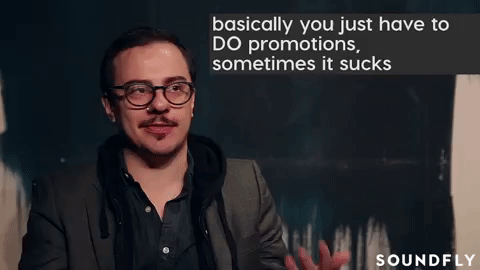The world of online promotion is a crowded one, with new music being released everyday, it can be difficult to get your work noticed at all. Unfortunately there’s not silver bullet when it comes to digital music promotion, but here we look some tips that can at least improve your chances.
_______________________
Guest post by James Shotwell from Soundfly’s Flypaper
Promoting your music online can sometimes feel like shouting into a void. The same, unfortunately, can often be said about pitching your music to the press. Between the ever increasing competition from new music being released every year and the limited amount of time most music blogs have to cover new talent, it’s very easy for an artist to spend hours, even days, sending emails to everyone they can find, only to receive little or no response at all.
Unfortunately, there is no super secret industry insider wizardry that’s going to make all the best blogs in the world start caring about your music. But that doesn’t mean it’s not going to happen for you! It just takes hard work and persistence, creativity, a whole lot of kindness, and some old-fashioned strategic planning.

So with that in mind, here are five keys to success every great artist such as yourself will need to internalize as you build your digital promotion strategy.
1. Branding and brand consistency matters.
The term brand consistency refers to any attempt to communicate messages in a way that doesn’t detract from your core brand strategy, values, and foundation. In other words, brand consistency is all about being yourself in everything that you do so that consumers know who you are, what you produce, and what your work is all about. Without brand consistency, consumers will lose sight of the message you are trying to convey, which in turn will cause them to lose interest. If they cannot understand what you are trying to do, they will find it hard to trust your future output, thus making it increasingly hard to convert listeners into supporters.
Branding doesn’t have to be a bad word for artists. You just need to establish the general contours of your identity as a guide for maintaining it in everything you do. Such efforts should include basic instructions on how to use all your branding tools (name, logo, typeface, photos, color palettes, etc.). Being specific is key. Know exactly how you want to be presented and find clear ways to communicate that to anyone who works with you moving forward. This includes publicists, booking agents, promoters, etc.
+ Work with a Soundfly Mentor on your branding in a goal-oriented Headliners Club session this month! Let us know what you’d like to work on here.
2. Piracy is still an issue. Address it.
A decade ago, we were all sold the idea that digital streaming could end the destruction to artists’ bottom lines caused by digital piracy by creating new, legal means to access music on demand. While services like Spotify and Apple Music have helped to monetize digital music, they have not helped in reducing piracy. Digital piracy in 2017 was worse than any previous year on record, and by 2020, the rate of theft online is expected to double.
With that in mind, artists have tons of tools available to them that allow them to promote without fear of theft. Haulix, for example, provides a secure platform to discreetly share new and unreleased music with industry professionals and influencers. They also offer anti-piracy tools, such as watermarking and two-factor authentication. Get your releases out there, but be safe about it, so you can make sure your royalty dollars are still coming in.
3. Relationships are everything. Network. Network. Network.
Networking matters more than you might think. That unknown band who suddenly got a feature in Rolling Stone? That’s networking in action. That local act that just signed with the label of your dreams? Networking made that happen. Is the DIY group all your friends keep talking about now opening tour dates for an international headliner? Networking.
Your skill level and/or knowledge as it relates to the music industry won’t mean a thing if you are unable to meet people professionally and make a good impression. Relationships mean more in music than virtually anything else. You’re more likely to be asked who you know and what you’ve done with or for them than where you went to college or what your GPA was. To succeed in this industry, you need strong work relationships, and the only way to develop those is by networking with your peers, and never being shy to meet new people, online and in-person.
4. Playlists are the new mixtapes.
Playlists are maybe the most significant music discovery tool that exists today. People of all ages use music to express themselves and curate a personal soundtrack that others are encouraged to use. In the age of Spotify and Apple Music, the same goes for brands. There are hundreds of brands curating playlists crafted to represent a particular mood or aesthetic, and there are millions of people engaging with those selections every week.

Placement on the right streaming playlist can do more for an artist than any blog or news publication, because an appearance on a favorite playlist provides both incomeand exposure. Even if everyone who subscribes to a playlist only hears a song once, the artist behind that song could see a substantial boost in plays and streaming revenue.
There are two approaches to playlist contention. The first is to submit your song to Spotify’s new Playlist Submission feature. The second and far more time-consuming method requires you think outside the box. Partner with other artists to promote one another on curated lists; contact blogs with branded playlists; ask fans to make their playlists of the own, etc.
Whatever you do, be careful to not fall prey to one of the many playlist scams out there. No one can guarantee placement on a playlist unless they control that playlist — no one.
5. What does your Insta-story look like?
Regardless of any technological revolution that may take place in the future, community will always be at the heart of any industry success story. The artists and groups who get ahead are most often able to do so because they’ve harnessed the reach of their digital following by empowering fans to be brand ambassadors in their own right. These artists engage with their fans to such a degree that their fans recruit others to join them. And in 2018, Instagram is where much of that community-building is taking place.
According to one report, more people engage with Instagram’s Story feature in a single day than use Twitter in an entire month. That’s a lot of consumption!
With this in mind, it is increasingly vital that artists create original content for their Instagram. This includes posts to your feed, as well as story updates. Share your creative process, rehearsals, and tour experiences, as well as information that helps followers better understand the people behind the music. Your Story should essentially function as a window into your world, documenting all that you do in pursuit of your goals. Doing so makes it possible for fans to feel involved in your journey and lets them participate in your success, so that those who support you will work extra hard to see you succeed.